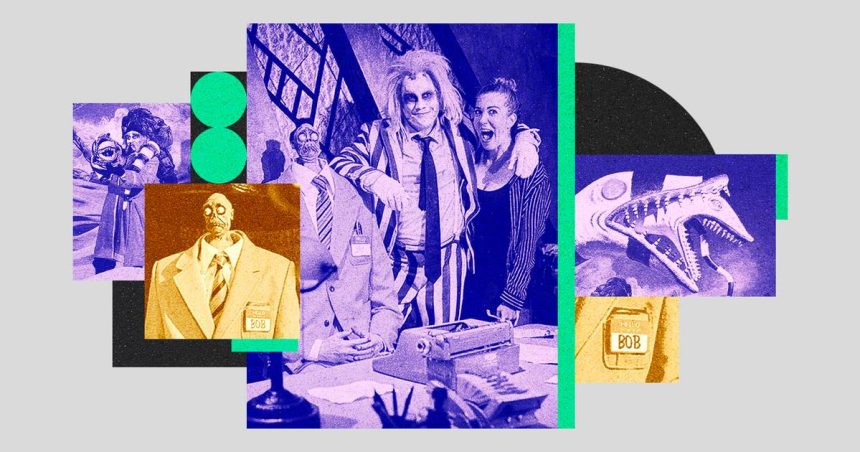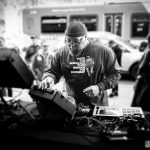This fall, Warner Bros. Discovery is giving fans of the Beetlejuice franchise the chance to see what the afterlife is really like.
In late August, ahead of the US theatrical release of Beetlejuice Beetlejuice, an “afterlife experience” opened up in Los Angeles, giving attendees the chance to immerse themselves in the world of the films. Visitors begin their journey to the afterlife in—where else—a waiting room, from which they are called to a window to consult with an afterlife caseworker and obtain an “Afterlife Passport” and a passport stamp. Once they’ve gained entry to the afterlife, they’ll be greeted by several interactive experiences, including a beauty salon called “Brush with Death” and a section for horoscope readings, according to Kathleen Wallis, VP of global themed entertainment at WBD.
The Beetlejuice Beetlejuice: The Afterlife Experience, which runs through mid-November, marks the first time that Wallis’s team has “worked that closely with the theatrical [marketing team] on a project like this,” she said, and while WBD declined to share attendance numbers, Wallis described it as “a big success.”
“This is now a blueprint for future collaborations,” she told Marketing Brew.
WBD is one of several entertainment companies making continued investments in experiential marketing as a way to engage with fans and hopefully incentivize them to come back to movie theaters or to their televisions by strengthening their relationships with some of their biggest titles.
“You spend so much time investing yourself into these worlds and into these characters,” said Eric Lee, partner and CTO of Stagwell’s Left Field Labs, which worked with Amazon’s Prime Video on an experiential activation The Boys and helped market The Wheel of Time. “When you actually get to step into that world and engage in that deeper way in person, you really do see that moment of magic that it sparks for people.”
Pushin’ daisies
Across the industry, experiential marketing is back in a big way. In 2024, global experiential marketing spend was expected to grow by 10.5%, the first year it’s projected to exceed prepandemic spend, according to market research firm PQ Media.
For studios and streamers, experiential marketing can help bring tried-and-true IP to life, giving fans a way to engage with a world they’re already familiar with—and, in some cases, get brands involved. To support its Beetlejuice activation, WBD inked several brand partnerships, including with hair-color brand Splat, whose products are featured in the salon; Denny’s, whose food, including “Beetlejuicy Sliders,” is featured in the “Afterlife Diner”; and Fanta, whose “Fanta Afterlife Train” includes a limited-edition Beetlejuice-themed soda called Haunted Apple available on the platform. Deodorant brand Secret is also getting in on the fun, with samples of its products available in the activation’s restrooms.
Get marketing news you’ll actually want to read
Marketing Brew informs marketing pros of the latest on brand strategy, social media, and ad tech via our weekday newsletter, virtual events, marketing conferences, and digital guides.
Beyond brand involvement, the activation also supported other parts of WBD’s marketing around the movie, Wallis said, including by providing a photogenic backdrop for earned media and social marketing facilitated by Warner Bros. Pictures.
“They brought influencers there,” Wallis said. “They had some press moments there as well, and they were in lockstep with us, with marketing the experience to drive awareness for the film.”
On trend
IP-based experiential activations generally serve to build consumers’ relationships with content and can help companies with beloved IP find additional ways to engage with consumers offscreen, Lee said.
“It’s just about establishing more of these different touchpoints outside of the content that you watch,” he said. “That’s how people feel more involved.”
At this year’s ComicCon in Brazil, Amazon’s Prime Video ran an experience centered on The Boys featuring a “magic mirror” that superimposed suits inspired by the show onto festivalgoers who participated in the activation, Lee said.
To evaluate the success of these kinds of installations, he said, his team measures both foot traffic as well as social posts borne from the event itself.
“In the case of The Boys activation, we generated a shareable asset for [Prime Video] and looked for, using hashtags, how often that has been posted,” he said. The foot traffic and social posts results “were beyond what we had set as sort of our goals for that activation,” he said.
Hulu has also turned some of its popular IP into IRL experiences. To promote the fourth season of Only Murders in the Building, the streamer brought back its popular escape room experience to New York in August and to Los Angeles in September.
Some streamers are looking to make experiential marketing investments full-time installations. In June, Netflix announced Netflix House, permanent retail locations in malls in Pennsylvania and Dallas designed to house consumer experiences. The first two locations will feature experiences tied to shows including Bridgerton and Stranger Things and will open in 2025.
Wallis, from WBD, said that certain titles, including Beetlejuice Beetlejuice, tend to be better-positioned to succeed in experiential settings since there is already a deep brand awareness of the IP in question. But Lee said just about anything can be turned experiential if those involved in building it understand the core of the title itself.
“When you truly have an appreciation for what the show is, what emotions it evokes, and what it is that lets people connect to that property, you can always find something in there to build an experience around,” he said.
Read the full article here










